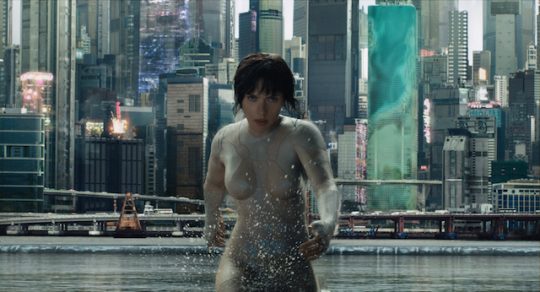This Ghost in the Shell review discusses some minor plot points for the first act; consider this your utterly superfluous spoiler warning.
Ghost in the Shell may not be perfect, but it's a propulsive picture littered with solid performances and stuffed with vivacious visuals that can't quite match its excellent acting.
Major (Scarlett Johansson) wakes up on the operating room table, her brain recently reconnected to a newly created cybernetic body given flesh by some sort of liquid goo. She can't breathe, she's drowning—it's okay, it's a memory. Dr. Ouelet (Juliette Binoche) calms her down, reassures her. Nothing can happen to her here. She's safe. She's been rebuilt. She's Hanka Robotics' six billion dollar gal, a human brain in a cybernetic body with superhuman speed and some sort of Predator-esque camouflaging system.
Director Rupert Sanders, working off a script credited to a trio of writers, introduces us to Major's abilities with refreshing brevity in this refreshingly brief (107 minutes) big-budget actioner. We jump to one year after Major's rebirth on Dr. Ouelet's operating table and see her perched on top of a building. She's talking to her aged boss Aramaki (Takeshi Kitano) and her on-the-ground backup Batou (Pilou Asbaek) about what she sees—not with her eyes, but inside her mind. She can hack the building's security, downloading and processing its audio and visual feeds. More impressively, perhaps, she can dive off the side of a skyscraper, turn invisible, and launch herself into martial arts action all whilst picking off villains with a series of American Sniper-caliber shots to the head.
The cybernetically enhanced killers she's taking out are working on behalf of Kuze (Michael Carmen Pitt*), who has sent his minions to extract the secrets inside of a Hanka Robotics scientist's melon—and is willing to kill any number of people to get it. Major wants to track down her cybernetically enhanced foe, but there's more at stake than the security of a robotics firm or the megalopolis she's trying to protect. What's truly at stake is her humanity—and the future of humanity, writ large.
I won't discuss more of the plot than this; you deserve to find out for yourself how deep the rabbit hole goes. Instead I'll focus a bit on the design, which is visually sumptuous but empty—a film that feels as though it's set 20 years in the future through the lens of 30 years in the past while being brought to life via the technology of the present. The idea of omnipresent free-floating holographic advertising isn't new or exciting or particularly well done here, giving Ghost in the Shell's cityscapes a sort of dated futurism, an almost retro vision of the future. It looks kind of neat in the ads but wearyingly boring for a feature-length film.
Far more interesting are the body modifications we see on individuals throughout Major's Tokyo: brain implants that connect individuals to each other and to their tech and eye upgrades that allow vision throughout the UV spectrum. How all this connects to Kuze's ideal for the next step in human evolution is fairly obvious—and utterly horrifying for those of us who can see we're about to be thrust into that realm now.
Johansson is perfectly cast as Major, taking the alien character struggling to adapt to humanity she portrayed in Under the Skin out of the arthouse and into the multiplex. Through Johansson's subtle eye movements and even subtler lip twitches we feel Major wrestling with her humanity, not quite sure where on the evolutionary ladder she stands. There's a harshness to the way she walks and the way she stands—Johansson isn't really tall enough to loom over anyone, and yet she's quite intimidating on the big screen,** a menacing apparition with killer moves.
There are few actresses today with the name recognition, the acting skills, and the action chops to pull off Ghost in the Shell's Major, and I'm thrilled Scarlett Johansson was chosen for the part. Here's to hoping that she'll continue to star in what should, by all rights, be a major franchise for years to come.
*Known to most of us as Michael Pitt, from Boardwalk Empire and The Dreamers, among other films. It is not entirely clear to me why he's adopted a new credit for Ghost in the Shell. It can't be because he's ashamed of the work he's done in this picture—Pitt is creepy but soulful, wearing a sneer and a tear with equal grace as his half-robotic form fidgets about the floor.
**Speaking of big screens: I must lodge a complaint about the Dolby Atmos theater at the AMC Georgetown. My viewing of Ghost in the Shell was rather hopelessly compromised by the fact that the top five-to-ten percent and the bottom 15 percent or so of the screen was cut off. All of the subtitles at the bottom of the screen were extremely difficult to make out. It wasn't entirely clear to me if this was a masking issue or a projection/screen ratio issue, but something was off—an unacceptable state of affairs, given the upcharge in pricing. I asked the theater staff to fix it and they were either unwilling or unable to; as a result, I'm forced to ask that someone at Dolby or AMC HQ checks out the Georgetown location to see what the problem is. Until they fix it, faithful readers, I suggest sticking to either IMAX or a standard screen. Save your cash—there's no reason to waste it on an inferior viewing experience.
